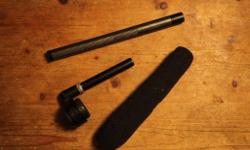Rode NT2 Condenser Microphone + Audio-Techniqua Shock Mount + Foam Windscreen in Brighton, East Sussex for sale




£160 ONO RØDE NT2 : Multi-Pattern Condenser Microphone + Shock Mount + Foam Windscreen (Sponge Cover) Item Description: This Rode NT2 Condenser Microphone comes with an Audio-Techniqua Shock Mount and Sponge Cover. Condition: This microphone is in very good condition with normal wear from use, including some staining on the body. It has been fully tested and sounds excellent. This is an excellent studio condenser sounding mic that works well on vocals and acoustic instruments. RØDE NT2 : Multi-Pattern Condenser Microphone The Rode NT2 was a large-diaphragm FET condenser that could be switched from Cardioid to Omni pickup patterns. It was a multipattern version of the NT1; the two microphones shared a circuit design. Both were designed by Jim Williams of Audio Upgrades. According to Jim Williams, both circuits used high-quality components, including Hitachi transistors, a JFET from Siliconix, Röderstein metal-film resistors and Wima polypropylene film caps. Every component on the circuit board was handpicked; as Williams describes them, the NT1 and NT2 were “pre-modded.” The specs for the mic changed over its lifetime; for example, the self-noise ranged from 14dBA to 17dBA. Max SPL ranged from 130 dB to 135 dB (or 145 with the pad). Whether these changes were due to circuitry improvements or test methodology changes is unknown. The capsule in both the NT1 and NT2 appear to be derivatives of the Neumann K67; both are center-terminated, and the photos we’ve seen reveal the characteristic K67 backplate drilling pattern. The NT2 version would have been a dual-diaphragm capsule, to enable the mic’s omnidirectional pattern. A switch on the mic body enabled either a high-pass filter, or a -10dB pad, or neither. The NT2 body was made of nickel-plated brass.
Sennheiser MKH 416 P48 Condenser Microphone (Broadcast Quality) + Shock Holder & Foam Screen
SM58 Microphone
Audio Speakers.
Cambridge Audio Amp






